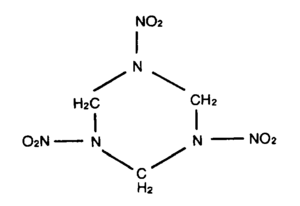RDX (explosive)
Among the most powerful of conventional explosives in general use, RDX, short for "Royal Demolition eXplosive" or "Research Department eXplosive", is also known as Hexogen or Cyclonite. It is usually employed in mixtures. [1]
Chemistry
Chemically, it is hexahydro-1,3,5-trinitro-1,3,5-triazine; It is a member of the nitramine class of organic nitrate explosives.
Characteristics
It has a brisance between 1.25 and 1.45 times that of TNT, and an explosive power of 1.51 to 1.70 by Trauzl test but 2.00 by field testing.
Applications
A variety of granular sizes are used in different explosive compositions, including:
- Composition A-3,
- Composition B
- Plastic explosives
- cyclotol
- Booster and detonator assemblies
- PBX (explosive)
- Insensitive high explosives
Alternatives
RDX can be manufactured as a polymer bound, insensitive high explosive form that has reduced sensitivity to sympathetic detonation. This form has a lower concentration, less than 0.5%, of HMX, a by-product of conventional RDX manufacture. It also has a higher density, such that its crystals have fewer voids producing less cavitations when transmitting a shock wave. [2]
Another alternative with comparable performance but less sensitivity to shock is nitrotriazolone.
References
- ↑ Military Explosives, U.S. Department of the Army, September 1984, TM 9-1300-214, pp. 8-30 to 8-38
- ↑ Dinesh Raghavan (December 2005), Design Methodology for Understanding the Sympathetic Detonation Charactistics of Insensitive High Explosives, Naval Postgraduate School, Master's Thesis, p. 19
